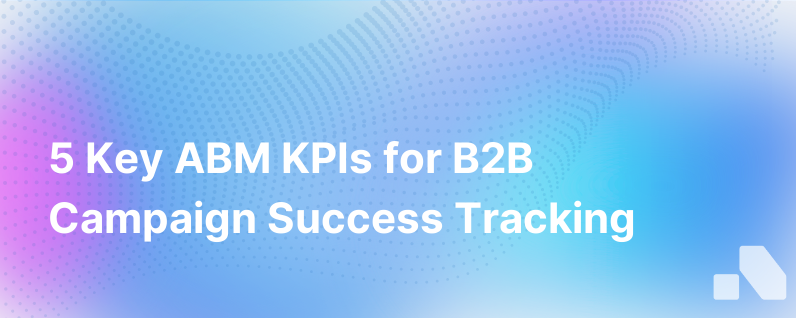
Account-Based Marketing (ABM) is a highly focused business strategy in which a marketing team treats an individual prospect or customer like its very own market. Executing a successful ABM advertising campaign requires careful planning and a precise success measurement strategy. Key Performance Indicators (KPIs) are used to quantify progress towards critical business objectives. The proper KPIs can make the difference between knowing your ABM campaign is on-target or merely guessing.
In this article, we will explore five essential KPIs to measure the success of B2B ABM advertising campaigns:
- Engagement Metrics
- Account Coverage
- Marketing Qualified Accounts (MQAs)
- Opportunity Conversion Rate
- ROI and Revenue Growth
1. Engagement Metrics
ABM isn't about casting the widest net; it's about fishing smarter. The premise is to engage qualitatively with the right people at the right accounts. Measuring engagement involves looking at the depth and the duration of interactions across all touchpoints in the target accounts. KPIs here include:
Webpage visits: Is there a spike in the number of visits from targeted accounts? Content interaction: Are the key stakeholders within these accounts downloading your whitepapers, attending webinars, or watching videos? Social interactions: Are they liking, commenting, sharing, or retweeting your content? Email engagement: Are targeted accounts opening your emails, clicking the links, and responding to them?
What’s unique in ABM is the focus on account-level engagement rather than individual leads. Measuring engagement gives you the pulse of your campaign's early traction and whether your content resonates with the target accounts.
### Engagement Metrics Example
| KPI | Baseline | Current | Goal | Notes |
| ----------------- | -------- | ------- | ---- | --------------------------------- |
| Webpage Visits | 150 | 200 | 300 | From targeted accounts only |
| Content Downloads | 30 | 50 | 75 | Whitepapers on industry solutions |2. Account Coverage
Quality over quantity is the mantra here. ABM campaigns aren't judged by how many leads they generate but how effectively they penetrate the targeted accounts. Account coverage measures whether the right individuals within an account are aware of and engaging with your brand. Some aspects to consider are:
Account reach: Are you reaching most of the buying committee within the target accounts? Role-specific engagement: Are senior decision-makers as engaged as the practitioners? Account penetration: Are multiple stakeholders within the account interacting with your campaign?
An increase in account coverage KPI usually foreshadows a higher conversion probability as it means a broader internal discussion about your offering within the account.
3. Marketing Qualified Accounts (MQAs)
Marketing Qualified Lead (MQL) is a common term in traditional marketing. In ABM, we apply the same principle at the account level—hence Marketing Qualified Account (MQA). MQAs are accounts that have shown a significant level of engagement that justifies further marketing and sales efforts. Consider the following:
Engagement scoring: Have they reached a threshold level of interaction with your marketing content? Intent data monitoring: Are they actively researching solutions or topics related to your offerings? ABM platform insights: If using an ABM platform, what's the level of account scoring?
Monitoring MQAs enables marketers to focus their efforts and budget on the accounts most likely to convert to opportunities, thereby optimizing the marketing spend.
### Tracking MQA Scoring
| Account | Engagement Score | Intent Signals | Threshold Met | Next Steps |
| --------------- | ---------------- | -------------- | ------------- | --------------- |
| GlobalTech Inc. | 75 | High | Yes | Sales follow-up |
| HealthSolutions | 50 | Medium | No | Nurture content |4. Opportunity Conversion Rate
The Opportunity Conversion Rate measures the efficacy of ABM campaigns in turning MQAs into sales opportunities. It scrutinizes the effectiveness of your marketing and sales teams in concert and is crucial for evaluating how well the ABM campaign is moving accounts through the sales pipeline.
Opportunity stages: From first contact to proposal presentation, how quickly are accounts moving forward? Conversion velocities: How fast are MQAs converting into opportunities compared to non-ABM efforts? Sales cycle length: Is ABM shortening the sales cycle for high-value accounts?
This KPI gives insight into the alignment of sales and marketing and the efficiency of the ABM strategy in terms of speeding up the buyer's journey.
5. ROI and Revenue Growth
Ultimately, the success of any marketing initiative boils down to its return on investment and contribution to revenue growth. In ABM, where campaigns are resource-intensive and highly tailored, it's vital to track:
Revenue attribution: Can specific deals be traced back to ABM efforts? Customer LTV (Lifetime Value): Is ABM helping to secure higher-value accounts with greater longevity? Cost of customer acquisition (CAC): Compared to other strategies, is ABM proving cost-effective in acquiring new customers?
ROI and revenue growth are the final arbitrators of success, representing the tangible outcomes of your ABM campaign.
### ROI Calculation Example
| Metric | Value |
| ------------------------------- | -------- |
| Total Revenue Attributed to ABM | $500,000 |
| Total ABM Campaign Investment | $100,000 |
| ROI | 400% |Conclusion
The ABM KPIs listed above provide a framework for measuring the effectiveness of B2B ABM advertising campaigns. Engagement metrics tell you whether targets are listening. Account coverage indicates market penetration. MQA identification shines a light on when to apply more resources to foster opportunities. Opportunity Conversion Rate offers insight into sales pipeline movement. Lastly, an analysis of ROI and revenue growth delivers the bottom-line impact of ABM initiatives.
For businesses, especially those in B2B sectors, ABM campaigns guided by these key performance indicators can be a clear path to impactful, revenue-generating marketing strategies. Analyzing the effectiveness of such campaigns, however, need not be a daunting task. With modern tools and platforms like Aomni that offer real-time insights and analytics, measuring success is both accurate and actionable, ensuring that your ABM campaigns deliver desired outcomes with precision and scalability.